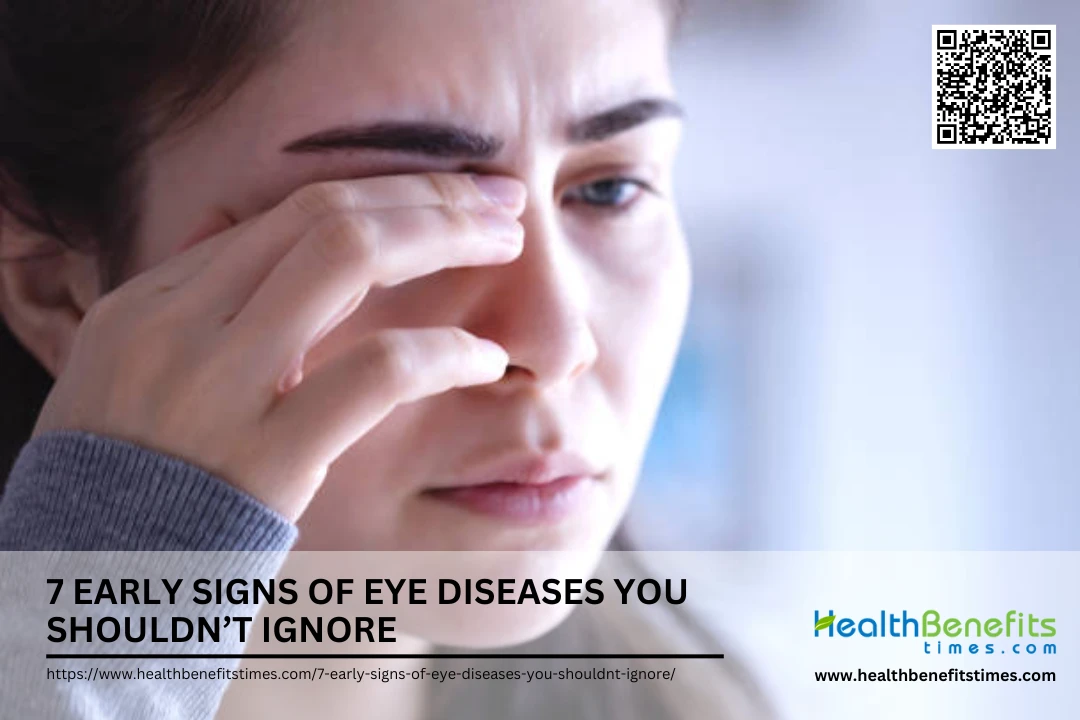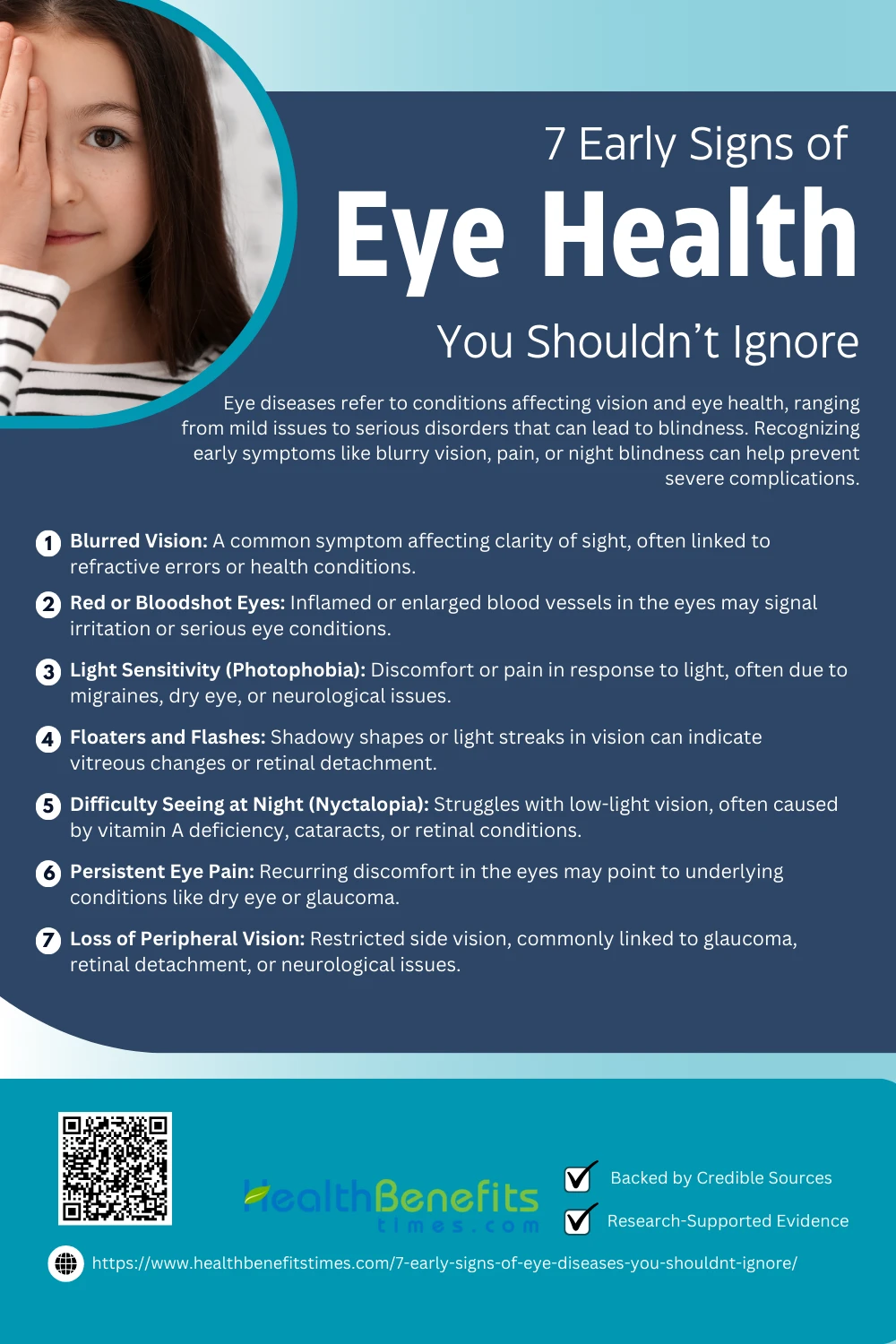- Eye diseases refer to conditions affecting vision and eye health, ranging from mild issues to serious disorders that can lead to blindness.
- Recognizing early symptoms like blurry vision, pain, or night blindness can help prevent severe complications.
- Timely eye exams and prompt action on warning signs are crucial for maintaining lifelong healthy vision.
 Eye diseases are medical conditions that impair the normal functioning of the eyes and, if untreated, can lead to vision loss or blindness (1). Recognizing the early warning signs of eye diseases is crucial for maintaining long-term vision health. Many common eye conditions, such as cataracts, glaucoma, and macular degeneration, begin with subtle symptoms that can easily go unnoticed. For instance, frequent eye strain and blurred vision could indicate underlying issues like diabetic retinopathy or refractive errors. Another symptom, persistent dry eyes, is often linked to conditions like keratoconjunctivitis sicca or autoimmune disorders such as Sjögren’s syndrome (2). Likewise, noticing halos around lights or sudden loss of peripheral vision could be an early indicator of glaucoma. Ignoring these early signs may result in progressive damage, emphasizing the importance of routine eye exams to catch and address issues in their initial stages. Additionally, age-related macular degeneration (AMD) often presents as difficulty seeing fine details or dark spots in the central vision (3). Educating yourself about these warning signs and seeking timely medical intervention can significantly prevent vision-related complications (4).
Eye diseases are medical conditions that impair the normal functioning of the eyes and, if untreated, can lead to vision loss or blindness (1). Recognizing the early warning signs of eye diseases is crucial for maintaining long-term vision health. Many common eye conditions, such as cataracts, glaucoma, and macular degeneration, begin with subtle symptoms that can easily go unnoticed. For instance, frequent eye strain and blurred vision could indicate underlying issues like diabetic retinopathy or refractive errors. Another symptom, persistent dry eyes, is often linked to conditions like keratoconjunctivitis sicca or autoimmune disorders such as Sjögren’s syndrome (2). Likewise, noticing halos around lights or sudden loss of peripheral vision could be an early indicator of glaucoma. Ignoring these early signs may result in progressive damage, emphasizing the importance of routine eye exams to catch and address issues in their initial stages. Additionally, age-related macular degeneration (AMD) often presents as difficulty seeing fine details or dark spots in the central vision (3). Educating yourself about these warning signs and seeking timely medical intervention can significantly prevent vision-related complications (4).
7 Early Signs of Eye Diseases You Shouldn’t Ignore
Protecting your vision starts with recognizing early warning signs. This article highlights seven crucial symptoms of eye diseases that should never be ignored for maintaining healthy eyes and preventing serious complications.
 1. Blurred Vision
1. Blurred Vision
Blurred vision is a common symptom affecting the clarity and sharpness of sight, often caused by refractive errors or underlying health conditions (5). It can range from temporary episodes to chronic impairment, impacting daily activities such as reading and driving.
Causes
Common causes of blurred vision include uncorrected refractive errors like myopia or hyperopia, cataracts, and glaucoma. Systemic conditions such as diabetes or migraines can also trigger episodes (6).
What to Do
If experiencing blurred vision, consult an eye care professional for a comprehensive exam. Addressing underlying causes with corrective lenses, medications, or surgery can prevent further complications.
2. Red or Bloodshot Eyes
Red or bloodshot eyes occur when the tiny blood vessels on the eye’s surface become inflamed or enlarged, often caused by irritation, dryness, or infection. While usually harmless, persistent redness may signal underlying eye conditions.
Causes
Common causes include dry eye syndrome, conjunctivitis, allergies, and environmental irritants (2; 5). Serious conditions like glaucoma or uveitis may also present with redness.
What to Do
Seek an eye care professional if redness persists or is accompanied by pain or vision changes. Treatment may involve artificial tears, medications, or addressing the root cause.
3. Light Sensitivity (Photophobia)
Light sensitivity, or photophobia, is a condition where exposure to light causes discomfort or pain in the eyes. It can range from mild irritation to severe sensitivity, significantly impacting daily life (7). Bright sunlight, fluorescent lights, or screens are common triggers.
Causes
Photophobia can result from migraines, dry eye syndrome, or corneal abrasions (8). Neurological disorders such as meningitis or traumatic brain injuries may also lead to heightened sensitivity (9).
What to Do
Managing photophobia involves identifying and treating its underlying causes. Protective eyewear, lubricating eye drops, or medications may alleviate symptoms. Consult an eye specialist if symptoms persist or worsen.
4. Floaters and Flashes
Floaters and flashes are visual phenomena often described as small spots or streaks of light in one’s vision. Floaters appear as shadowy shapes drifting across the field of view, while flashes resemble brief lightning streaks. They are typically more noticeable against bright backgrounds or when looking at a blank wall.
Causes
These symptoms are commonly caused by age-related changes in the vitreous, the gel-like substance in the eye, leading to posterior vitreous detachment (10). Retinal tears or detachment may also present with flashes, requiring immediate medical attention (11).
What to Do
If floaters and flashes suddenly increase or are accompanied by vision loss, consult an eye care specialist promptly. Regular eye exams and monitoring can help detect serious conditions early.
5. Difficulty Seeing at Night (Nyctalopia)
Nyctalopia, or night blindness, is the difficulty of seeing clearly in low-light conditions. It is not a disease but rather a symptom of an underlying issue affecting the retina or optic nerves (12). People with nyctalopia often struggle to navigate dimly lit environments, especially while driving at night.
Causes
Common causes include vitamin A deficiency, retinitis pigmentosa, and cataracts (13). Diabetes and glaucoma medications may also impair night vision (14).
What to Do
Addressing the root cause through dietary changes, like increasing vitamin A intake, or treating conditions such as cataracts can help. Regular eye exams can detect and manage progressive issues early.
6. Persistent Eye Pain
Persistent eye pain refers to prolonged or recurring discomfort in or around the eyes, often indicating underlying health issues. It may be accompanied by symptoms such as redness, blurred vision, or light sensitivity. While occasional eye discomfort can be benign, chronic pain warrants medical evaluation.
Causes
Common causes include dry eye syndrome, corneal abrasions, and eye strain (2). More serious conditions like glaucoma, uveitis, or optic neuritis may also contribute to prolonged pain.
What to Do
Consult an eye specialist if pain persists or worsens. Treatment may involve lubricating drops, medications, or addressing underlying conditions. Regular eye exams help diagnose and manage potential issues early.
7. Loss of Peripheral Vision
Loss of peripheral vision, also known as tunnel vision, restricts the ability to see objects outside the direct line of sight. This condition can affect mobility and daily activities, often indicating an underlying eye or neurological issue.
Causes
Common causes include glaucoma, retinal detachment, and stroke-related damage to the brain’s visual pathways (11). Other causes include optic neuritis, brain injuries, or tumors affecting visual processing (15).
What to Do
Timely medical intervention is crucial. Treatment options may include medications, surgery, or vision therapy depending on the cause. Regular eye exams and monitoring help detect progressive conditions early.
When to See an Eye Specialist
Seeing an eye specialist is essential for symptoms like sudden vision loss, persistent eye pain, or frequent headaches, as these could indicate conditions like retinal detachment or glaucoma. Issues like floaters, flashes, or red eyes accompanied by discharge may signal retinal tears or infections (16). Sensitivity to light and difficulty seeing at night could suggest neurological or retinal problems (7; 17). Regular checkups are vital for managing chronic conditions like diabetes (14).
Conclusion
Your eyes are essential to your quality of life, and recognizing the early signs of potential eye diseases can make a significant difference in preserving your vision. Symptoms like blurry vision, persistent pain, or sudden changes in sight should never be ignored, as they could indicate serious underlying conditions. Regular eye check-ups and prompt attention to these warning signs are key to preventing long-term damage and maintaining optimal eye health. Don’t wait—prioritize your vision today and take proactive steps to ensure a brighter, clearer future.
References:
- National Library of Medicine. (n.d.). What is Eye Disease?
- Mayo Clinic. (n.d.). Causes of Dry Eye
- National Library of Medicine. (n.d.). AMD Early Detection
- National Center for Biotechnology Information. (n.d.). Benefits of Early Eye Care
- National Library of Medicine. (n.d.). Blurred Vision Overview
- National Library of Medicine. (n.d.). Diabetes and Vision Issues
- National Library of Medicine. (n.d.). Photophobia Overview
- Mayo Clinic. (n.d.). Migraine and Photophobia
- National Center for Biotechnology Information. (n.d.). Neurological Causes of Photophobia
- National Library of Medicine. (n.d.). Vitreous Detachment and Floaters
- Mayo Clinic. (n.d.). Retinal Detachment Symptoms
- National Library of Medicine. (n.d.). Nyctalopia Overview
- (n.d.). Retinitis Pigmentosa Causes
- Mayo Clinic. (n.d.). Diabetes and Night Vision
- (n.d.). Neurological Causes of Vision Loss
- National Library of Medicine. (n.d.). Red Eyes and Infections
- National Eye Institute. (n.d.). Night Blindness

